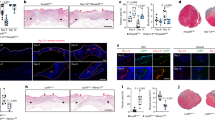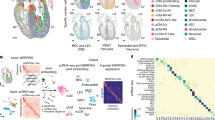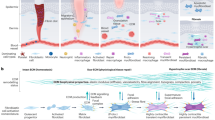Abstract
This protocol describes a unique in vitro method for the generation of a 3D human lymphatic network within native connective tissue devoid of any exogenous material such as scaffolds or growth factors. In this five-stage protocol, human lymphatic endothelial cells (LECs) cocultured with dermal fibroblasts spontaneously organize into a stable 3D lymphatic capillary network. Stage 1 involves the isolation of primary fibroblasts and LECs from human skin. Fibroblasts are then cultured to produce connective tissue rich in extracellular matrix (stage 2), onto which LECs are seeded to form a network (stage 3). After stacking of tissue layers and tissue maturation at the air–liquid interface (stage 4), the 3D construct containing the lymphatic microvascular network can be analyzed by microscopy (stage 5). Lymphatic vasculature generated by this approach exhibits the major cellular and ultrastructural features of native in vivo human dermal lymphatic microvasculature and is stable over many weeks. The protocol for generating a 3D construct takes 6 weeks to complete, and it requires experience in cell culture techniques. The system described here offers a unique opportunity to study the mechanisms underlying lymphatic vessel formation, remodeling and function in a human cell context.
This is a preview of subscription content, access via your institution
Access options
Access Nature and 54 other Nature Portfolio journals
Get Nature+, our best-value online-access subscription
$29.99 / 30 days
cancel any time
Subscribe to this journal
Receive 12 print issues and online access
$259.00 per year
only $21.58 per issue
Buy this article
- Purchase on Springer Link
- Instant access to full article PDF
Prices may be subject to local taxes which are calculated during checkout






Similar content being viewed by others
References
Gibot, L. et al. Cell-based approach for 3D reconstruction of lymphatic capillaries in vitro reveals distinct functions of HGF and VEGF-C in lymphangiogenesis. Biomaterials 78, 129–139 (2016).
Black, A.F., Berthod, F., L′Heureux, N., Germain, L. & Auger, F. In vitro reconstruction of a human capillary-like network in a tissue-engineered skin equivalent. FASEB J. 12, 1331–1340 (1998).
Tremblay, P.L., Hudon, V., Berthod, F., Germain, L. & Auger, F.A. Inosculation of tissue-engineered capillaries with the host′s vasculature in a reconstructed skin transplanted on mice. Am. J. Transplant. 5, 1002–1010 (2005).
Gibot, L., Galbraith, T., Huot, J. & Auger, F.A. A preexisting microvascular network benefits in vivo revascularization of a microvascularized tissue-engineered skin substitute. Tissue Eng. Part A 16, 3199–3206 (2010).
Gibot, L., Galbraith, T., Huot, J. & Auger, F.A. Development of a tridimensional microvascularized human skin substitute to study melanoma biology. Clin. Exp. Metastasis 30, 83–90 (2013).
Dixon, J.B., Raghunathan, S. & Swartz, M.A. A tissue-engineered model of the intestinal lacteal for evaluating lipid transport by lymphatics. Biotechnol. Bioeng. 103, 1224–1235 (2009).
Helm, C.L., Zisch, A. & Swartz, M.A. Engineered blood and lymphatic capillaries in 3-D VEGF-fibrin-collagen matrices with interstitial flow. Biotechnol. Bioeng. 96, 167–176 (2007).
Podgrabinska, S. et al. Molecular characterization of lymphatic endothelial cells. Proc. Natl. Acad. Sci. USA 99, 16069–16074 (2002).
Nipper, M.E. & Dixon, J.B. Engineering the lymphatic system. Cardiovasc. Eng. Technol. 2, 296–308 (2011).
Weitman, E., Cuzzone, D. & Mehrara, B.J. Tissue engineering and regeneration of lymphatic structures. Future Oncol. 9, 1365–1374 (2013).
Cao, R. et al. PDGF-BB induces intratumoral lymphangiogenesis and promotes lymphatic metastasis. Cancer Cell 6, 333–345 (2004).
Cao, R. et al. Mouse corneal lymphangiogenesis model. Nat. Protoc. 6, 817–826 (2011).
Mandriota, S.J. et al. Vascular endothelial growth factor-C-mediated lymphangiogenesis promotes tumour metastasis. EMBO J. 20, 672–682 (2001).
Skobe, M. et al. Induction of tumor lymphangiogenesis by VEGF-C promotes breast cancer metastasis. Nat. Med. 7, 192–198 (2001).
Tabibiazar, R. et al. Inflammatory manifestations of experimental lymphatic insufficiency. PLoS Med. 3, e254 (2006).
Bruyere, F. & Noel, A. Lymphangiogenesis: in vitro and in vivo models. FASEB J. 24, 8–21 (2010).
Bruyere, F. et al. Modeling lymphangiogenesis in a three-dimensional culture system. Nat. Methods 5, 431–437 (2008).
Marino, D., Luginbuhl, J., Scola, S., Meuli, M. & Reichmann, E. Bioengineering dermo-epidermal skin grafts with blood and lymphatic capillaries. Sci. Transl. Med. 6, 221ra214 (2014).
Dai, T.T. et al. Reconstruction of lymph vessel by lymphatic endothelial cells combined with polyglycolic acid scaffolds: a pilot study. J. Biotechnol. 150, 182–189 (2010).
Kim, S., Chung, M. & Jeon, N.L. Three-dimensional biomimetic model to reconstitute sprouting lymphangiogenesis in vitro. Biomaterials 78, 115–128 (2016).
Boa, O. et al. Prospective study on the treatment of lower-extremity chronic venous and mixed ulcers using tissue-engineered skin substitute made by the self-assembly approach. Adv. Skin Wound Care 26, 400–409 (2013).
Ng, C.P., Helm, C.L. & Swartz, M.A. Interstitial flow differentially stimulates blood and lymphatic endothelial cell morphogenesis in vitro. Microvasc. Res. 68, 258–264 (2004).
Athanasiou, K.A., Eswaramoorthy, R., Hadidi, P. & Hu, J.C. Self-organization and the self-assembling process in tissue engineering. Annu. Rev. Biomed. Eng. 15, 115–136 (2013).
Madi, M., Rols, M.P. & Gibot, L. Efficient invitro electropermeabilization of reconstructed human dermal tissue. J. Membr. Biol. 248, 903–908 (2015).
Acknowledgements
This work was supported by US Department of Defense grant BC044819 and by the DRPPP Pilot Project Program, Department of Oncological Sciences, Mount Sinai (M.S., A.R.), Canadian Institute of Health Research (CIHR) grant SAC92850 (F.A.A.) and the Fondation d'entreprise SILAB-Jean Paufique (L.G.).
Author information
Authors and Affiliations
Contributions
L.G., F.A.A. and M.S. designed the study. L.G., T.G., J.B. and A.R. conducted the experiments. L.G., T.G., J.B., A.R., M.S. and F.A.A. analyzed the data. L.G., T.G. and M.S. wrote the manuscript.
Corresponding authors
Ethics declarations
Competing interests
The authors declare no competing financial interests.
Rights and permissions
About this article
Cite this article
Gibot, L., Galbraith, T., Bourland, J. et al. Tissue-engineered 3D human lymphatic microvascular network for in vitro studies of lymphangiogenesis. Nat Protoc 12, 1077–1088 (2017). https://doi.org/10.1038/nprot.2017.025
Published:
Issue Date:
DOI: https://doi.org/10.1038/nprot.2017.025
This article is cited by
-
Human disease models in drug development
Nature Reviews Bioengineering (2023)
-
A 3D Human Lymphatic Vessel-on-Chip Reveals the Roles of Interstitial Flow and VEGF-A/C for Lymphatic Sprouting and Discontinuous Junction Formation
Cellular and Molecular Bioengineering (2023)
-
Networked lymphatic endothelial cells in a transplanted cell sheet contribute to form functional lymphatic vessels
Scientific Reports (2022)
-
Lymphatic Tissue Engineering and Regeneration
Journal of Biological Engineering (2018)
-
Tissue-engineered 3D melanoma model with blood and lymphatic capillaries for drug development
Scientific Reports (2018)
Comments
By submitting a comment you agree to abide by our Terms and Community Guidelines. If you find something abusive or that does not comply with our terms or guidelines please flag it as inappropriate.



